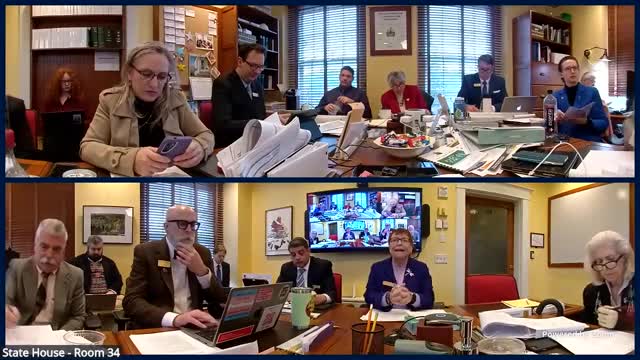Sponsor outlines H.349 to create Vermont State Building Security Board and a buildings police department
April 03, 2025 | Corrections & Institutions, HOUSE OF REPRESENTATIVES, Committees, Legislative , Vermont
This article was created by AI summarizing key points discussed. AI makes mistakes, so for full details and context, please refer to the video of the full meeting. Please report any errors so we can fix them. Report an error »

The Admissions Committee on Thursday heard Representative Mary Howard present H.349, a bill proposing creation of a Vermont State Building Security Board to assume responsibility for security planning in state-owned and state-leased facilities (excluding the State House) and to establish a Buildings and Courthouse Police Department within the Department of Public Safety.
Howard described the board's membership and duties: two members appointed by the governor, the Vermont State Court Administrator or designee, one member appointed by the attorney general, and three members appointed by the president of the Vermont State Employees Association. The bill would require the board to hold at least four regular meetings a year and authorize the board to develop security plans for state-owned and leased properties. The bill also authorizes a Buildings and Courthouse Police Department within the Department of Public Safety; the department's chief would be appointed and removable at the commissioner's pleasure and its officers would be classified as state employees.
"We need this independent board," Howard said, arguing the change would remove politics from operational security decisions and make planning and funding requests more public and predictable. She invoked safety concerns among state employees and cited the murder of Lara Sobel as an event that spurred additional security planning.
Committee discussion focused on practical implications and scope. Members asked whether county courthouses and sheriff-contracted courthouse security would be affected; Howard and members confirmed the bill contemplates county courthouses and that current sheriff-contracted security arrangements would be implicated and need clarification. Members pressed for fiscal estimates; Howard and others said specific funding magnitudes were not available at the hearing and would require briefings with Buildings and General Services (BGS) and the Department of Public Safety.
Committee next steps: Members agreed to request an overview from BGS on how security is currently provided in state-owned and leased facilities, how leases allocate security responsibilities, and how courthouse security is provided under current sheriff contracts. The committee discussed whether to have the legislative counsel or BGS walk through the bill text and concluded the first step should be an operational briefing from BGS.
Open questions noted by members: the fiscal cost of creating and staffing a new statewide force, the effect on existing sheriff-contracted county courthouse security, how the board's authority would interact with building leases when private owners supply security, and whether BGS or the new board would want to retain or cede operational control. Members also asked for clarity about which buildings the new force would be expected to staff in person and about training and classification of officers.
No formal vote was taken on H.349; the committee agreed to pursue additional information and to schedule a briefing with BGS and appropriate stakeholders.
Howard described the board's membership and duties: two members appointed by the governor, the Vermont State Court Administrator or designee, one member appointed by the attorney general, and three members appointed by the president of the Vermont State Employees Association. The bill would require the board to hold at least four regular meetings a year and authorize the board to develop security plans for state-owned and leased properties. The bill also authorizes a Buildings and Courthouse Police Department within the Department of Public Safety; the department's chief would be appointed and removable at the commissioner's pleasure and its officers would be classified as state employees.
"We need this independent board," Howard said, arguing the change would remove politics from operational security decisions and make planning and funding requests more public and predictable. She invoked safety concerns among state employees and cited the murder of Lara Sobel as an event that spurred additional security planning.
Committee discussion focused on practical implications and scope. Members asked whether county courthouses and sheriff-contracted courthouse security would be affected; Howard and members confirmed the bill contemplates county courthouses and that current sheriff-contracted security arrangements would be implicated and need clarification. Members pressed for fiscal estimates; Howard and others said specific funding magnitudes were not available at the hearing and would require briefings with Buildings and General Services (BGS) and the Department of Public Safety.
Committee next steps: Members agreed to request an overview from BGS on how security is currently provided in state-owned and leased facilities, how leases allocate security responsibilities, and how courthouse security is provided under current sheriff contracts. The committee discussed whether to have the legislative counsel or BGS walk through the bill text and concluded the first step should be an operational briefing from BGS.
Open questions noted by members: the fiscal cost of creating and staffing a new statewide force, the effect on existing sheriff-contracted county courthouse security, how the board's authority would interact with building leases when private owners supply security, and whether BGS or the new board would want to retain or cede operational control. Members also asked for clarity about which buildings the new force would be expected to staff in person and about training and classification of officers.
No formal vote was taken on H.349; the committee agreed to pursue additional information and to schedule a briefing with BGS and appropriate stakeholders.
View full meeting
This article is based on a recent meeting—watch the full video and explore the complete transcript for deeper insights into the discussion.
View full meeting